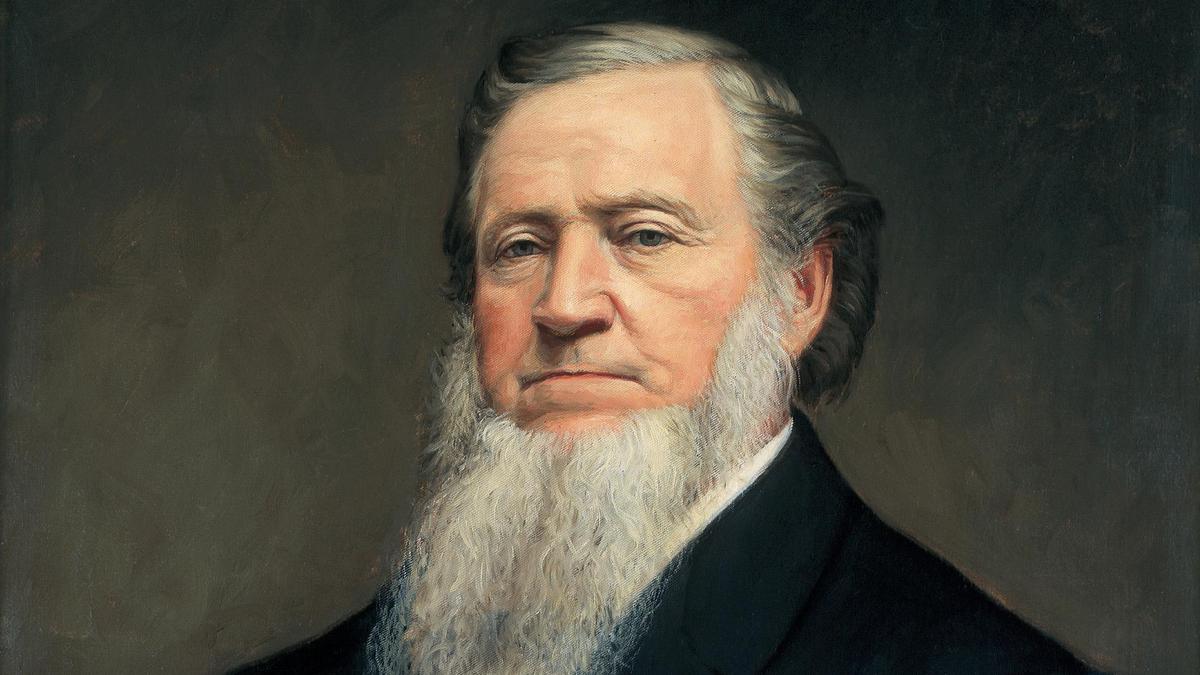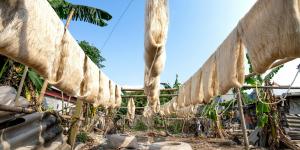You are here
How Did Brigham Young Help Take the Book of Mormon to the World?

1 Nephi 5:18
The Know
On September 21, 1827, in Port Byron, New York, a young craftsman looked out into the night’s sky and witnessed a “heavenly vision” unfold before his eyes, “a great army marching in perfect unison from the east to the west until it filled the surrounding horizon.”1 That same night, roughly 30 miles to the west, Joseph Smith pulled the plates of gold from the earth.2 Joseph would go on to translate and publish the Book of Mormon, but it would be Brigham Young, the craftsman from Port Byron, who would begin to take the Book of Mormon to “all nations, kindreds, tongues, and people” (1 Nephi 5:18).
Brigham recalled that the Book of Mormon first “came to my hands in two or three weeks” after publication. Joseph’s brother Samuel Smith had left a copy in Mendon, New York with Brigham’s brother Phineas. The book quickly passed through the hands of several members of the Young family, and while some were already singing its praises, Brigham remained skeptical. “Hold on,” he remembered thinking, “Wait a little while.” He recalled, “I examined the matter studiously for two years before I made up my mind to receive that book.”3
Finally, in April 1832, Brigham heard Eleazer Miller, “a man without eloquence, or talents for public speaking,” bear “simple, unadorned testimony” of the Book of Mormon. After 2 years of deliberation, Brigham said, “My own judgment, natural endowments, and education bowed to this simple, but mighty testimony.”4 He was baptized that next Sunday, on April 15, 1832.5
Twelve years later, Brigham Young was the President of the Quorum of the Twelve when Joseph and his brother Hyrum were tragically killed in Carthage Jail.6 In the midst of that tragedy, competing voices arose seeking to fill the leadership void left behind by the Prophet. As Brother Brigham humbly sought to do the Lord’s will and what was best for the Saints, many witnessed the mantle of Joseph miraculously pass to Brigham Young.7
The Prophet's mantle came with many responsibilities, including the charge to share the Book of Mormon with the world. Brigham had already played a key role in taking the Book of Mormon oversees as an apostle. He presided over the Church in Great Britain, where he and other members of the Quorum of the Twelve oversaw the publication of the 1841 Liverpool edition of the Book of Mormon—the first edition printed outside the United States.8 Brigham would oversee another printing of the Book of Mormon in Nauvoo in 1845, after Joseph’s death.9
The Book of Mormon influenced the Saints as they settled in their new territory, which Brigham dubbed “Deseret,” a Book of Mormon name for the honeybee.10 Like others who settled out west, the Saints ran into many conflicts with the Native Americans, but because of the belief that they were “Lamanites,” Brigham attempted to establish more benevolent policies toward the Native Americans, though they were not always followed.11 Brother Brigham also felt inspired to establish temples in certain places, like St. George and Manti, because he believed Moroni or another ancient Nephite had dedicated that land.12
By the early 1850s, missionaries had been sent out again, and it was during Brigham Young’s time as president of the Church that the first foreign language editions of the Book of Mormon were published. It started with the Danish edition in 1851, followed in 1852 by Welsh, French, Italian and German, and then Hawaiian in 1855.13 Selections of the Book of Mormon in Spanish were published in 1875.14 Brigham “rejoiced when those translations appeared in print.”15
In his teachings, Brigham often emphasized that the Bible and Book of Mormon testify of each other. He had a firm conviction that “no man or woman, can say the Book of Mormon is true, and at the same time say that the Bible is untrue.”16 He taught that the Book of Mormon “proves that the Bible is true” and that “the two prove each other true.”17 Brigham was so certain that sincere believers in the Bible would believe in the Book of Mormon, that he taught, “we do not ask you to believe” the Book of Mormon. “What we do ask is that you will believe what is recorded in the Holy Bible …. Do this in all honesty and sincerity, then you will know that the Book of Mormon is true.”18
Several of Brigham Young’s doctrinal teachings were also derived from the Book of Mormon as well.19 For example, Brigham taught, “When God speaks to the people, he does it in a manner to suit their circumstances and capacities,” a doctrine first explained by Nephi (2 Nephi 31:3).20 He applied this to the Book of Mormon itself, teaching “if the Book of Mormon were now to be re-written, in many instances it would materially differ from the present translation.”21
The Why
Although Brigham Young approached the Book of Mormon with caution at first, he came to play an important role in spreading the book throughout the world. He was one of the first to carry it across the seas, and oversaw the publication of the first edition printed outside the United States. During his presidency, missionaries began to carry it to the far reaches of the earth, and several foreign language editions were published. With Brigham Young at the helm, the Book of Mormon began to “go forth unto all nations, kindreds, tongues, and people” (1 Nephi 5:18).
Brigham Young’s example and teachings can still help guide us today. His conversion reminds us of the important role of the Book of Mormon in missionary work, and the power of simple testimonies of its truthfulness. Like Brigham and the early Saints settling in the Salt Lake Valley and surrounding area, the Book of Mormon can be a guiding influence as we face challenges and go through transitions in our lives. For Brigham Young, the Book of Mormon “formed one of the pillars on which he rested some of his most important teachings.”22 Today, we can likewise use the Book of Mormon as one of the pillars of our lives.
Brother Brigham’s understanding that revelation—including the Book of Mormon translation—is tailored to the circumstances in which it is given remains important to understand today. After only approximately thirty years since the Book of Mormon had been published, according to President Young, a new divine translation would have differed noticeably. We should not be surprised, therefore, if the translated Book of Mormon contains phrases and imagery best suited for an early 19th century translation—such would be expected in order for the divine translation to most effectively communicate with the Lord’s intended audience.
Brigham’s teachings about the Book of Mormon and the Bible also remain relevant today. As Elder Russell M. Nelson recently reaffirmed, “Love for the Book of Mormon expands one’s love for the Bible and vice versa. … The Book of Mormon restores and underscores biblical doctrines such as tithing, the temple, the Sabbath day, and the priesthood.”23
Latter-day Saints throughout the world can and should appreciate the impact the Book of Mormon had on Brigham Young—and, in turn, the impact he had on the spread of that book throughout the world.
Further Reading
W. Jeffrey Marsh, “Brigham Young and the Book of Mormon,” Journal of Book of Mormon Studies 10, no. 2 (2002): 6–15, 69.
“The Scriptures,” in Teachings of the Presidents of the Church: Brigham Young (Salt Lake City, UT: The Church of Jesus Christ of Latter-day Saints, 1997), 118–124.
- 1. W. Jeffrey Marsh, “Brigham Young and the Book of Mormon,” Journal of Book of Mormon Studies 10, no. 2 (2002): 9.
- 2. This vision was also seen by several others, such as the Kimballs and Greens, living in Mendon, NY (15 miles west of the Hill Cumorah), who would also join the Church. See Marsh, “Brigham Young and the Book of Mormon,” 8–9.
- 3. All quotations in this paragraph are from Journal of Discourses 3:91 (1856).
- 4. All quotations in this paragraph are from Journal of Discourses 1:90–91 (1854).
- 5. For a fuller version of Brigham’s conversion story, see Marsh, “Brigham Young and the Book of Mormon,” 9–10; Leonard J. Arrington, Brigham Young: American Moses (New York, NY: Alfred A. Knopf, 1985), 19–30.
- 6. On the martyrdom of Joseph Smith, see Book of Mormon Central, “What Does it Mean to be a Martyr? (Ether 12:37, 39),” KnoWhy 1 (January 1, 2016).
- 7. See Lynn Watkins Jorgensen, “The Mantle of the Prophet Joseph Passes to Brother Brigham: One Hundred Twenty-Nine Testimonies of a Collective Spiritual Witness,” in Opening the Heavens: Accounts of Divine Manifestations, 1820–1844, 2nd edition, ed. John W. Welch (Salt Lake City and Provo, UT: Deseret Book and BYU Studies, 2017), 395–429 (transcriptions of all the primary sources of this event are available on pp. 430–507). See also Arrington, Brigham Young, 113–117.
- 8. Marsh, “Brigham Young and the Book of Mormon,” 15. See also, “Book of Mormon, Liverpool Edition, 1841,” online at history.lds.org; Richard E. Turley Jr. and William Slaughter, How We Got the Book of Mormon (Salt Lake City, UT: Deseret Book, 2011), 67–78. In 1844, Brigham had two copies of this edition ornately bound and given to Queen Victoria.
- 9. Marsh, “Brigham Young and the Book of Mormon,” 15.
- 10. Marsh, “Brigham Young and the Book of Mormon,” 13; Arrington, Brigham Young, 223; Jeffery Ogden Johnson, “Deseret, State of,” in Encyclopedia of Mormonism, 4 vols., ed. Daniel H. Ludlow (New York, NY: Macmillan, 1993), 1:371–373.
- 11. See Arrington, Brigham Young, 210–222; Donald R. Moorman, Camp Floyd and the Mormons: The Utah War (Logan, UT: Utah State University Press, 1992), 177–191.
- 12. See John L. Lund, Joseph Smith and the Geography of the Book of Mormon (Salt Lake City, UT: The Communications Company, 2012), 134–135.
- 13. Marsh, “Brigham Young and the Book of Mormon,” 15. On the Danish edition, see Trent Toone, “Danish: The First Foreign Language Edition of the Book of Mormon,” Deseret News, February 21, 2012, online at deseretnews.com.
- 14. Marsh, “Brigham Young and the Book of Mormon,” 15.
- 15. Marsh, “Brigham Young and the Book of Mormon,” 15.
- 16. Journal of Discourses 1:38 (1854).
- 17. Journal of Discourses 13:134–135 (1871).
- 18. Journal of Discourses 13:335 (1871). See also Journal of Discourses 1:38 (1854).
- 19. See Marsh, “Brigham Young and the Book of Mormon,” 14–15.
- 20. Journal of Discourses 9:311 (1862). See also Doctrine and Covenants 1:24. For more on this idea, see Book of Mormon Central, “Why Does the Lord Speak to Men ‘According the Their Language’ (2 Nephi 31:3),” KnoWhy 258 (January 6, 2017).
- 21. Journal of Discourses 9:311 (1862).
- 22. Marsh, “Brigham Young and the Book of Mormon,” 8.
- 23. Elder Russell M. Nelson, “Scriptural Witnesses,” Ensign, November 2007, 43.
KnoWhy Citation
Related KnoWhys
Subscribe
Get the latest updates on Book of Mormon topics and research for free





